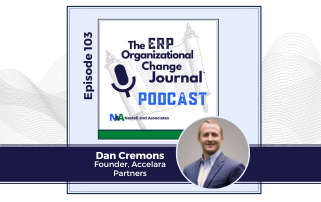Leveraging machine learning to enhance organizational performance.
Article Contents
- Machine Learning in ERP
- The Challenge of ERP Implementation and Optimization is Real
- Why Utilize ERP Organizational Change Research?
- What Exactly Does “Data-Driven Insights” Mean?
- What Does Machine Learning Have to Do With “Data-driven Insight”?
- What is an Algorithm?
- What is a Machine Learning Algorithm?
- What is The Difference Between Machine Learning and Artificial Intelligence?
- How have Machine Learning Algorithms Advanced in the Last Decade?
- What is Predictive Analytics?
- What Are Some Challenges with Machine Learning Algorithms in ERP today?
- What Issues May Be Solved by ML Integration in ERP?
- How Will we Know the Value of ML Integrating Into ERP systems?
- The Future ML and ERP
Machine Learning in ERP
“ML algorithms characterized by their ability to extract intricate patterns from vast datasets are being harnessed to enable ERP systems to make more accurate predictions and data-driven decisions. Therefore, ML enables ERP systems to adapt dynamically based on real-time insights, resulting in enhanced efficiency and adaptability.” (Jawad, Z. N., & Balázs, V., 2024)
Zainab and Villányi, thank you for your work, “Machine learning‑driven optimization of enterprise resource planning (ERP) systems: a comprehensive review”. (Jawad, Z. N., & Balázs, V. (2024). Machine learning-driven optimization of enterprise resource planning (ERP) systems: a comprehensive review. Beni-Suef University Journal of Basic and Applied Sciences, 13(1), 4.)
This paper examines the integration of machine learning (ML) algorithms into enterprise resource planning (ERP) systems, marking a paradigm shift in traditional business operations. By leveraging ML capabilities, ERP systems evolve into intelligent platforms capable of predictive analytics, adaptive automation, and personalized user experiences. Jawad and Balázs (2024) offer CxOs, ERP practitioners, and ERP stakeholders a look into the future of ERP organizational performance. The paper offers readers a lucid insight into the contemporary advancements within this ever-evolving domain of artificial intelligence and machine learning (ML).
By referencing Zainab and Villányi, the goal of this article is to further share and break down the ideas shared in their paper. This article offers a conversation and examination of the incorporation of machine learning algorithms into ERP applications. Jawad and Balázs (2024) offer an examination of recent publications, providing valuable insights for ERP stakeholders and practitioners alike.
This article aims to:
- Highlight key points from Jawad and Balázs’ (2024) article on machine learning (ML) in enterprise resource planning (ERP) systems.
- Offer general insights into ML’s role in ERP, primarily for organizational ERP stakeholders.
- Discuss fundamental topics related to machine learning in ERP, including:
- The significance of ERP organizational change research.
- Understanding “Data-Driven Insights” and their importance.
- The connection between machine learning and data-driven insights.
- Basic concepts such as algorithms, machine learning algorithms, and the distinction between machine learning and artificial intelligence.
- Advances in machine learning algorithms over the past decade.
- Current challenges of implementing machine learning in ERP contexts.
- The role of predictive analytics within ERP.
- Potential issues addressed by integrating ML into ERP systems.
- Determining the value of machine learning integration in ERP systems.
So, let’s jump in!
The Challenge of ERP Implementation and Optimization is Real
What is the problem that machine learning in ERP could help solve? As discussed in previous articles, including “The ERP Challenge: The Background”, ML could potentially be utilized to solve many ERP organizational change challenges and improve organizational performance. The significance of Enterprise Resource Planning systems in modern business operations is substantial. ERP benefits such as process automation and enhanced collaboration are fundamental goals of ERP deployments. Despite their potential for improving efficiency, ERP implementations often face significant challenges. These challenges include high ERP implementation failure rates and substantial costs.
There is variability in ERP implementation methods, with some approaches yielding positive results while others result in setbacks. Successful ERP implementation requires attention to various components including business analysis, software selection, and organizational culture management. Additionally, intangible factors such as leadership and organizational culture play crucial roles in ERP success.
Despite advancements in technology, the core challenges of ERP projects have remained consistent since the 1990s. However, organizations that confront these challenges effectively can unlock the full potential of ERP solutions, driving sustainable growth and competitive advantage in the digital era. Embracing awareness, agility, and strategic foresight is essential for navigating the complexities of ERP implementation and turning challenges into opportunities for innovation and growth. Machine Learning in ERP would be one such innovation for holistic ERP improvement (implementation, optimization, and overall organizational performance).

ERP Organizational Change research offers insight and opportunities for contribution to ERP organizational success and improvement.
Why Utilize ERP Organizational Change Research?
Why Utilize ERP Organizational Change Research? Because work such as Jawad and Balázs’ (2024), like the extensive work of many more, offers insight and opportunity for contribution to ERP organizational success and improvement. As described in a previous Article, “Applied Research is a Competitive Advantage”, the importance of perpetual learning and applied research in organizations is substantial. Emphasizing experience alone during ERP organizational change is not enough for success; reflection, learning, and application are crucial.
The significance of evaluated experience is real, where methods are continuously assessed and improved upon. The use of applied research by ERP practitioners is stressed as a means to gain insights for reflection and improvement. Additionally, ERP research advocates for an environment of organizational culture and learning, where innovation and creativity thrive, thus leading to sustainable competitive advantages. A business consulting approach grounded in systematic inquiry and scientific methodology, aiming to generate context-specific solutions for organizational development and improvement is required of ERP organizational change success. Furthermore, the ever-changing nature of organizational contexts underscores the enduring importance of theory-based research.
As ERP practitioners navigate the dynamic landscape, embracing and applying high-quality research becomes a cornerstone for success. In doing so, ERP vendors, researchers, practitioners, and stakeholders not only enhance their capabilities but also fulfill their commitment to organizational stakeholders in achieving meaningful and sustainable ERP organizational change.
What Exactly Does “Data-Driven Insights” Mean?
ML approaches have the ability to convert ERPs into intelligent, adaptable, and decision-supportive platforms by utilizing the strength of data-driven insights and predictive analytics. (Jawad, Z. N., & Balázs, V., 2024)
“Data-driven insights” refer to conclusions, patterns, or knowledge derived from the analysis of data. In various fields such as business, science, technology, and healthcare, organizations collect vast amounts of data from various sources such as customer interactions, transactions, sensors, or experiments. By employing analytical techniques, statistical methods, and machine learning algorithms, this data can be processed and analyzed to uncover meaningful patterns, trends, correlations, and relationships. These insights can then be used to make informed decisions, optimize processes, predict future outcomes, identify opportunities, mitigate risks, and drive overall performance improvements. The term “data-driven” emphasizes the importance of using empirical evidence and quantitative analysis to guide decision-making, rather than relying solely on intuition, opinion, subjective views, or anecdotal evidence.
Here are the basic steps and fundamental idea behind “data driven insight”:
- Data Collection: The process starts with collecting relevant data from various sources. This could include structured data (e.g., databases, spreadsheets) and unstructured data (e.g., text documents, social media posts, images).
- Data Cleaning and Preparation: Raw data often contains errors, inconsistencies, or missing values. Before analysis, data needs to be cleaned and prepared, which involves tasks such as removing duplicates, handling missing data, and standardizing formats.
- Data Analysis: Once the data is prepared, it’s subjected to analysis using various statistical and computational techniques. This could include descriptive statistics to summarize the data, exploratory data analysis to identify patterns and trends, and inferential statistics to make predictions or draw conclusions about a larger population.
- Visualization: Data visualization techniques such as charts, graphs, and dashboards are often used to present the results of the analysis in a clear and understandable format. Visualization can help in identifying patterns, trends, and outliers more effectively than examining raw data.
- Insight Generation: Through analysis and visualization, insights are derived from the data. These insights could include correlations between variables, identification of key drivers of a phenomenon, anomalies in the data, or predictions about future trends or events.
- Validation and Interpretation: It’s essential to validate the insights to ensure they are robust and reliable. This may involve testing hypotheses, conducting sensitivity analyses, or comparing results with existing knowledge or external benchmarks. Once validated, the insights need to be interpreted in the context of the problem or domain to extract actionable recommendations.
- Decision-Making and Action: Finally, the insights generated from the data analysis inform decision-making processes. Organizations can use these insights to formulate strategies, allocate resources, optimize operations, improve products or services, or address challenges and opportunities effectively.
- Iterative Process: Data-driven insights are often part of an iterative process. As new data becomes available or as circumstances change, organizations continuously analyze data to update their insights and adapt their strategies accordingly.
“Data-driven insight”, done right, can certainly empower organizations to make evidence-based decisions, leading to improved efficiency, innovation, and competitiveness.
What Does Machine Learning Have to Do With “Data-driven Insight”?
Machine learning plays a crucial role in generating data-driven insights by using algorithms (which we will discuss further in a moment) to extract patterns, trends, and relationships from data. Here’s how machine learning contributes to the process of deriving insights:
- Pattern Recognition: Machine learning algorithms can identify complex patterns and relationships within the data that may not be apparent through traditional statistical methods. These algorithms are capable of detecting patterns across large datasets and can uncover correlations, clusters, or trends that human analysts might miss.
- Prediction and Forecasting: Machine learning models can be trained to predict future outcomes based on historical data. By analyzing patterns in past behavior, these models can forecast future trends, customer behavior, market dynamics, and other variables of interest. These predictions provide valuable insights for decision-making and strategic planning.
- Classification and Segmentation: Machine learning algorithms can categorize data into different classes or segments based on their characteristics. This capability is useful for tasks such as customer segmentation, fraud detection, sentiment analysis, and anomaly detection. By classifying data, organizations can gain insights into different segments of their target audience or identify unusual patterns that may indicate potential problems or opportunities.
- Personalization and Recommendation: Machine learning enables personalized recommendations by analyzing user preferences, behavior, and historical interactions with products or services. These recommendation systems use algorithms to identify relevant items or content for individual users, enhancing user experience and driving engagement. Insights from machine learning algorithms help organizations tailor their offerings to the specific needs and preferences of their customers.
- Optimization and Automation: Machine learning optimization algorithms can optimize processes, workflows, and resource allocation by analyzing large amounts of data and identifying the most efficient strategies. These algorithms can automate decision-making in areas such as supply chain management, pricing optimization, inventory management, and logistics planning. By leveraging machine learning insights, organizations can streamline operations, reduce costs, and improve overall efficiency.
- Continuous Learning and Adaptation: Machine learning models can adapt to new data and changing circumstances, allowing organizations to continuously refine their insights and predictions. Through techniques such as online learning and reinforcement learning, machine learning systems can update their models in real time based on incoming data, ensuring that insights remain relevant and accurate over time.
Machine learning enhances the process of deriving data-driven insights by leveraging advanced algorithms to analyze, interpret, and extract valuable knowledge from large and complex datasets. By combining machine learning with other analytical techniques, organizations can unlock new opportunities, mitigate risks, and make informed decisions based on empirical evidence.
What is an Algorithm?
As mentioned above, machine learning in ERP requires algorithms. But, what is an algorithm? An algorithm is a set of step-by-step instructions or a finite sequence of well-defined computational steps that, when followed, accomplish a specific task or solve a particular problem. Algorithms can be expressed in various forms, including natural language, pseudocode, flowcharts, or programming languages. Key characteristics of algorithms include:
- Precise Instructions: Algorithms provide clear and unambiguous instructions for performing a task or solving a problem. Each step must be well-defined and executable.
- Finite: Algorithms must terminate after a finite number of steps. They cannot continue indefinitely without reaching a conclusion.
- Deterministic: Given the same input, an algorithm should produce the same output every time it is executed. It should be predictable and consistent.
- Effective: Algorithms should produce correct results and solve the intended problem efficiently within a reasonable amount of time and resources.
Algorithms are used extensively in computer science and programming to automate tasks, make decisions, manipulate data, and solve problems across various domains. They serve as the building blocks of software applications and systems, enabling computers to perform a wide range of functions, from simple calculations to complex data analysis and machine learning tasks. Examples of algorithms include sorting algorithms (e.g., bubble sort, quicksort), searching algorithms (e.g., binary search), graph algorithms (e.g., Dijkstra’s algorithm for shortest paths), encryption algorithms (e.g., RSA encryption), and machine learning algorithms (e.g., decision trees, neural networks). Here are some examples of ML algorithms as described in Jawad and Balázs (2024): LSTM, Random forest, decision trees, genetic algorithm, Liner programming, reinforcement learning, K-means, Neural networks, Isolation forest, auto-encoders, One-class SVM, and simulation models.

Algorithms enable machines to improve their performance on a specific task over time.
What is a Machine Learning Algorithm?
The consequences of integrating machine learning algorithms into an ERP system provide decision-makers with valuable insights that help them make better decisions.” (Jawad, Z. N., & Balázs, V., 2024)
A machine learning algorithm is a computational technique or method used by machines (computers) to learn from data and make predictions or decisions without being explicitly programmed to perform the task. These algorithms enable machines to improve their performance on a specific task over time by learning from experience, patterns, and feedback from the data. As a quick summary, machine learning algorithms can be categorized into several broad types, including:
- Supervised Learning: In supervised learning, the algorithm learns from labeled data, where each example in the dataset is associated with a corresponding label or outcome. The algorithm’s goal is to learn a mapping from input features to the correct output label. Common supervised learning algorithms include linear regression, logistic regression, decision trees, random forests, support vector machines (SVM), and neural networks.
- Unsupervised Learning: Unsupervised learning involves learning from unlabeled data, where the algorithm aims to discover hidden patterns, structures, or relationships within the data. Unlike supervised learning, there are no predefined output labels. Clustering algorithms, such as k-means clustering and hierarchical clustering, and dimensionality reduction techniques, such as principal component analysis (PCA) and t-distributed stochastic neighbor embedding (t-SNE), are examples of unsupervised learning algorithms.
- Semi-Supervised Learning: Semi-supervised learning techniques combine elements of both supervised and unsupervised learning. These algorithms leverage a small amount of labeled data along with a larger pool of unlabeled data to improve learning performance. Semi-supervised learning is useful when labeled data is scarce or expensive to obtain.
- Reinforcement Learning: Reinforcement learning involves training an agent to interact with an environment in order to maximize cumulative rewards. The agent learns by taking actions, receiving feedback (rewards or penalties) from the environment, and adjusting its behavior accordingly. Reinforcement learning algorithms, such as Q-learning and deep Q-networks (DQN), have been successfully applied to tasks such as game playing, robotics, and autonomous vehicle control.
- Deep Learning: Deep learning is a subfield of machine learning that focuses on learning representations of data through layered architectures called neural networks. Deep learning algorithms, particularly deep neural networks, have demonstrated remarkable performance in tasks such as image recognition, natural language processing, speech recognition, and medical diagnosis.
Machine learning algorithms can vary in complexity, scalability, interpretability, and suitability for different types of data and tasks. Selecting the appropriate algorithm depends on factors such as the nature of the data, the problem domain, the available computational resources, and the desired performance metrics.
What is The Difference Between Machine Learning and Artificial Intelligence?
Machine learning and artificial intelligence (AI) are closely related concepts, but they represent different aspects of computer science and technology. Short answer, Machine Learning is a subset of Artificial intelligence. That said, here is a high-level summary:
- Artificial Intelligence (AI): AI is a broad field of computer science concerned with creating systems or machines that can perform tasks that typically require human intelligence. These tasks may include problem-solving, reasoning, learning, perception, language understanding, and decision-making. AI encompasses a wide range of techniques, methodologies, and approaches, including machine learning, natural language processing, computer vision, expert systems, robotics, and knowledge representation. The goal of AI is to develop systems that can mimic or simulate human-like intelligence to varying degrees, depending on the specific application and context.
- Machine Learning (ML): Machine learning is a subset of AI focused on the development of algorithms and models that enable computers to learn from data and make predictions or decisions without being explicitly programmed to perform the task. ML algorithms learn patterns, trends, and relationships from data by processing large datasets and extracting insights through statistical analysis, pattern recognition, and computational techniques. The primary objective of machine learning is to enable machines to improve their performance on a specific task or domain by learning from experience, feedback, and data. Machine learning algorithms can be categorized into supervised learning, unsupervised learning, semi-supervised learning, reinforcement learning, and deep learning, each with its own set of techniques and applications.
AI is a broader concept that encompasses the development of intelligent systems, while machine learning is a specific approach within AI that focuses on enabling machines to learn from data and improve their performance over time. Machine learning is a key technology used to achieve AI’s goals, but AI also includes other techniques and methodologies beyond just machine learning.
How have Machine Learning Algorithms Advanced in the Last Decade?
How have machine learning algorithms advanced in the last decade? Or, to ask the same question another way, why has ML become such a significant opportunity for ERP in the last decade? Machine learning algorithms have advanced significantly over the past decade, leading to breakthroughs in various fields (and enabling the development of more sophisticated AI systems). Some of the key advancements in machine learning algorithms over the last decade include:
- Deep Learning Revolution: One of the most significant advancements in machine learning has been the rise of deep learning, a subfield of machine learning inspired by the structure and function of the human brain’s neural networks. Deep learning algorithms, particularly deep neural networks with many layers, have achieved remarkable performance improvements in tasks such as image recognition, natural language processing, speech recognition, and game playing.
- Neural Network Architectures: Researchers have developed increasingly complex and powerful neural network architectures, including convolutional neural networks (CNNs) for image processing, recurrent neural networks (RNNs) for sequential data, long short-term memory networks (LSTMs) for handling long-range dependencies, and transformer architectures for natural language processing tasks.
- Transfer Learning and Pretrained Models: Transfer learning techniques have become prevalent, allowing models pretrained on large datasets (e.g., ImageNet for images, BERT for natural language processing) to be fine-tuned on smaller, task-specific datasets. This approach enables faster training and better performance on new tasks, even with limited labeled data.
- Generative Models: Generative models, such as generative adversarial networks (GANs) and variational autoencoders (VAEs), have emerged as powerful tools for generating realistic synthetic data, creating deepfakes, enhancing images, and generating novel content in various domains.
- Reinforcement Learning Advances: Reinforcement learning algorithms have made significant progress, particularly in the application of deep reinforcement learning for solving complex tasks in robotics, game playing, autonomous vehicles, and resource optimization.
- Interpretability and Explainability: There has been a growing focus on developing interpretable and explainable machine learning models to understand the decisions made by algorithms, especially in critical domains such as healthcare, finance, and criminal justice.
- Efficiency and Scalability: Efforts have been made to improve the efficiency and scalability of machine learning algorithms, including the development of hardware accelerators (e.g., GPUs, TPUs), distributed training frameworks (e.g., TensorFlow, PyTorch), and model compression techniques to deploy models on resource-constrained devices.
- AutoML and Automated Machine Learning: AutoML techniques have emerged to automate the process of model selection, hyperparameter tuning, and feature engineering, making machine learning more accessible to users with limited expertise.
These advancements have propelled machine learning to new heights, enabling the further development of machine learning in ERP systems with unprecedented capabilities and paving the way for future innovations.
What is Predictive Analytics?
Predictive analytics is a branch of advanced analytics that uses data, statistical algorithms, and machine learning techniques to forecast future events or behaviors. It involves analyzing historical data to identify patterns and trends and then using those insights to make predictions about future outcomes. Predictive analytics can be applied across various domains, including finance, marketing, healthcare, retail, and more. The process of predictive analytics typically involves several steps:
- Defining the problem: This step involves clearly defining the problem or the outcome you want to predict. For example, it could be predicting customer churn, forecasting sales, or identifying potential fraud.
- Data collection and preparation: Relevant data needs to be collected from various sources and prepared for analysis. This may involve cleaning the data, handling missing values, and transforming the data into a suitable format for analysis.
- Exploratory data analysis (EDA): EDA involves exploring the data to understand its characteristics, identify patterns, and detect anomalies. This step helps in gaining insights into the data before building predictive models.
- Feature selection and engineering: In this step, relevant features (variables) that are most predictive of the outcome are selected or engineered from the data. Feature engineering involves creating new features or transforming existing ones to improve the performance of predictive models.
- Model selection and training: Various predictive modeling techniques such as regression, classification, time series analysis, and machine learning algorithms are applied to the data. These models are trained on historical data to learn the underlying patterns and relationships.
- Model evaluation: The performance of the predictive models is evaluated using appropriate metrics such as accuracy, precision, recall, or ROC-AUC (Receiver Operating Characteristic – Area Under the Curve). This step helps in assessing how well the models are able to make predictions on unseen data.
- Deployment and monitoring: Once a satisfactory predictive model is developed, it is deployed into production to make predictions on new data. It’s essential to monitor the model’s performance over time and update it as necessary to ensure its continued accuracy and relevance.
Predictive analytics can provide valuable insights and help organizations make data-driven decisions, optimize processes, mitigate risks, and gain a competitive edge in their respective industries.
What Are Some Challenges with Machine Learning Algorithms in ERP today?
What are some of the challenges with implementing and optimizing machine learning algorithms in the context of ERP today? Implementing and optimizing machine learning algorithms in the context of Enterprise Resource Planning (ERP) systems can pose several challenges:
- Data Integration and Quality: ERP systems typically store vast amounts of data from various business processes and departments. However, integrating this data for machine learning purposes can be challenging due to differences in data formats, structures, and quality across different modules or systems. Ensuring data consistency, completeness, and accuracy is crucial for training reliable machine learning models.
- Data Privacy and Security: ERP systems often contain sensitive business data, such as financial records, customer information, and proprietary information. Ensuring data privacy and security while implementing machine learning algorithms requires robust encryption, access controls, and compliance with regulatory requirements (e.g., GDPR, HIPAA).
- Complexity and Customization: ERP systems are highly complex and customizable to meet the specific needs of organizations. Integrating machine learning algorithms into existing ERP systems may require extensive customization, development, and integration efforts to align with existing business processes, workflows, and user interfaces.
- Scalability and Performance: Machine learning algorithms can be computationally intensive, especially when processing large volumes of data in real-time. Ensuring scalability and performance while deploying machine learning models within ERP systems may require optimizing algorithms, leveraging distributed computing frameworks, or using specialized hardware accelerators.
- Interpretability and Explainability: Machine learning models deployed within ERP systems should be interpretable and explainable to facilitate decision-making and compliance with regulatory requirements. Ensuring transparency and understanding of model predictions is essential, particularly in critical domains such as finance, healthcare, and compliance.
- Change Management and User Adoption: Introducing machine learning capabilities into ERP systems may require changes to existing business processes, workflows, and user interfaces. Ensuring effective change management, training, and user adoption is crucial to realizing the benefits of machine learning and gaining acceptance from end-users and stakeholders.
- Maintenance and Monitoring: Machine learning models deployed within ERP systems require regular maintenance, monitoring, and updates to ensure continued performance and relevance over time. Establishing mechanisms for monitoring model performance, detecting drift, and retraining models with new data is essential to avoid degradation in predictive accuracy and reliability.
Addressing these challenges will require a holistic approach involving collaboration between ERP vendors, ML developers, and experts, IT professionals, and business stakeholders to design, implement, and optimize machine learning solutions within ERP systems effectively.
What Issues May Be Solved by ML Integration in ERP?
Integrating machine learning (ML) into enterprise resource planning (ERP) systems can address several key issues and provide various benefits. Here are some common challenges that ML integration can help solve in ERP systems:
- Demand Forecasting: ML algorithms can analyze historical sales data, market trends, and other relevant factors to predict future demand more accurately. This helps in optimizing inventory levels and production planning, reducing stockouts, and minimizing excess inventory.
- Inventory Optimization: ML algorithms can optimize inventory levels by analyzing demand patterns, lead times, seasonality, and other factors. This leads to better inventory management, reduced carrying costs, and improved customer service levels.
- Predictive Maintenance: ML algorithms can analyze equipment sensor data to predict equipment failures before they occur. This enables proactive maintenance scheduling, reduces downtime, and extends the lifespan of assets.
- Quality Control: ML algorithms can analyze data from various sources to detect patterns and anomalies in the production process. This helps in identifying quality issues early, reducing defects, and improving product quality.
- Supplier Relationship Management: ML algorithms can analyze supplier performance data, market conditions, and other factors to optimize supplier selection, negotiate better terms, and mitigate risks in the supply chain.
- Personalized Marketing: ML algorithms can analyze customer data, purchase history, and behavior patterns to personalize marketing campaigns and promotions. This improves customer engagement, retention, and sales.
- Fraud Detection: ML algorithms can analyze transaction data and identify patterns indicative of fraudulent activities. This helps in detecting and preventing fraud in financial transactions, procurement processes, and other areas.
- Optimized Pricing: ML algorithms can analyze market conditions, competitor pricing, and customer behavior to optimize pricing strategies dynamically. This maximizes revenue and profitability while remaining competitive.
- Workflow Automation: ML algorithms can automate routine tasks and decision-making processes, such as invoice processing, purchase order approvals, and resource allocation. This improves efficiency, reduces errors, and frees up employees to focus on more strategic tasks.
By addressing these challenges, ML integration in ERP systems can significantly enhance operational efficiency, reduce costs, improve decision-making, and drive business growth.
How Will We Know the Value of Integrating ML Into ERP systems?
What are the objective metrics that demonstrate that Machine Learning will provide concrete time, cost, and effort savings for ERP systems and therefore business performance? To be clear, there is very little doubt of the organizational capital savings (time, money, effort) that organizations will realize. The honest answer to this question is that the anecdotal verdict is still out in terms of the real value that organizations will realize. Additionally, this benefit will vary by ERP system, organizational context, and other factors. As the ML technology continues to evolve and to be further deployed in ERP systems, a key to success is for the organization to expend the time and effort to define metrics at the onset of an ERP organizational change (i.e. implementation effort). Learn more here, “ERP Organizational Change Metrics”. As machine learning in ERP evolves and more ERP vendors incorporate ML into their products, there are no doubts that ERP organizational change researchers will be examining the benefits and evolution of ML much closer. In the meantime, for organizations to demonstrate concrete time, cost, and effort savings resulting from machine learning (ML) integration in ERP systems and its impact on business performance, they must determine and measure various objective metrics at the onset of an ERP implementation. If ML is going to be what it is chalked up to be (which it will be), there will certainly be observed positive changes in organizational metrics.
Here are some key metrics as examples:
- Inventory Turnover: Measure how quickly inventory is sold and replaced over a specific period. ML-driven demand forecasting and inventory optimization can help reduce excess inventory, leading to higher inventory turnover ratios and lower carrying costs.
- Lead Time Reduction: Measure the time it takes from placing an order to receiving it. ML algorithms can optimize supply chain processes, reduce lead times, and improve supplier performance, resulting in faster order fulfillment and reduced procurement costs.
- Production Efficiency: Measure the utilization of resources and equipment in the production process. ML-driven predictive maintenance and quality control can minimize downtime, reduce defects, and improve overall production efficiency.
- Forecast Accuracy: Measure the accuracy of demand forecasts compared to actual sales. ML algorithms can improve forecast accuracy, reducing stockouts and excess inventory while optimizing production schedules, leading to cost savings and improved customer satisfaction.
- Supplier Performance: Measure supplier performance in terms of delivery reliability, lead times, quality, and pricing. ML-driven supplier relationship management can help identify and work with high-performing suppliers, negotiate better terms, and mitigate risks, resulting in cost savings and operational efficiency.
- Customer Retention and Lifetime Value: Measure customer retention rates and lifetime value. ML-driven personalized marketing and customer analytics can improve customer engagement, loyalty, and retention, leading to increased sales and profitability over the long term.
- Process Automation: Measure the reduction in manual effort and time spent on routine tasks. ML-driven workflow automation can streamline processes such as invoice processing, purchase order approvals, and data entry, freeing up employees to focus on higher-value tasks and improving productivity.
- Revenue and Profit Growth: Measure the impact of ML-driven pricing optimization, cross-selling, and upselling strategies on revenue and profitability. ML algorithms can identify pricing opportunities, recommend personalized product recommendations, and optimize sales strategies, leading to revenue growth and improved margins.
- Employee Productivity: Measure improvements in employee productivity and satisfaction resulting from ML-driven process automation and decision support. ML algorithms can provide employees with real-time insights and recommendations, enabling them to make faster and more informed decisions, leading to time savings and increased efficiency.
By tracking these objective metrics before and after ML integration in ERP systems, businesses can quantitatively assess the tangible benefits and return on investment (ROI) of leveraging ML technology to improve business performance.
The Future of ML and ERP
As Jawad and Balázs (2024) also share in their work, while machine learning in ERP offers significant benefits, it also presents evolutionary challenges such as data accuracy and algorithm complexity. Their text (as well as Nestell & Associates) advocates for continued research and collaboration to address ML challenges and explore scalable solutions tailored to the evolving needs of organizations, particularly in large enterprises. There is no doubt there are a significant transformative potential of ML-driven ERP optimization, paving the way for increased productivity, competitiveness, and innovation in the digital era. Machine Learning in ERP underscores the importance of ongoing research and development to harness the full capabilities of ML technology in unique organizational settings and to drive continuous improvement in business operations.
The Final Thought
The exploration of machine learning (ML) within enterprise resource planning (ERP) systems unveils a transformative landscape for business operations, grounded in the insights from the comprehensive review by Jawad and Balázs (2024). This discussion has highlighted the pivotal role of ML algorithms in advancing ERP efficiency through predictive analytics and data-driven decision-making, presenting a forward-looking blueprint for organizations aiming to harness these technologies. From addressing the nuances of ERP implementation challenges to unlocking new opportunities for optimization and strategic growth, the integration of ML into ERP signifies a leap towards more adaptive, efficient, and intelligent business systems.
However, navigating this terrain comes with its set of complexities, including data integration, privacy concerns, and the continuous evolution of ML algorithms. The journey toward integrating ML into ERP systems underscores the necessity for a strategic approach, underpinned by the collaboration between technology developers, business leaders, and the academic community. As we delve deeper into the era of digital transformation, the intersection of ML and ERP holds the promise of reshaping the future of business performance, driving organizations towards a paradigm of innovation, agility, and sustained competitive advantage. The essence of this evolution lies not just in adopting new technologies but in fostering a culture of continuous improvement and strategic foresight.
Dr. Jack G. Nestell
References
- Jawad, Z. N., & Balázs, V. (2024). Machine learning-driven optimization of enterprise resource planning (ERP) systems: a comprehensive review. Beni-Suef University Journal of Basic and Applied Sciences, 13(1), 4. Available at: https://link.springer.com/article/10.1186/s43088-023-00460-y
If Integrating Machine Learning into ERP Systems is Crucial for Your Organization's Growth or Aligns with Your Research Interests, We Want to Connect with You.
Whether aiming to transform your business operations or advance research in this field, your expertise is invaluable. Let’s explore how we can collaborate and drive innovation together. Reach out to discuss potential opportunities and share your insights. Join us in shaping the future of ERP and machine learning integration.
You Might Also Like These Related Articles:
The Future of ERP: Intrinsically Linked to the Evolution of Artificial Intelligence
Intelligent ERP Systems: Artificial Intelligence and Its Impact on ERP Organizational Change
What do ERP Critical Success Factors and Artificial Neural Networks have in Common?
What is ERP Organizational Change Research? And, Why Should You Care?
Bias in Artificial Intelligence-Enabled ERP Software Customization: Say whaaat?!
Related Podcast Episodes from “The ERP Organizational Change Journal” Podcast:
Episode 85: Harnessing AI for ERP Innovation: Balancing Growth, Ethics, and Governance
Episode 89: AI’s Role in ERP and Organizational Evolution
Episode 38: How Artificial Intelligence is Transforming the ERP Systems
Latest Podcast Episodes – “The ERP Organizational Change Journal”
Human Capital in PE-Backed Companies: Strategies for Leadership and Talent Management
Human Capital in PE-Backed Companies: Strategies for Leadership and Talent ManagementEpisode Overview - PE-backed Human Capital Strategies Today’s episode centers on the pivotal role of human capital in PE-backed companies, emphasizing how strategic leadership and...
ERP Organizational Change: Technology Strategy
ERP Organizational Change: Technology Strategy and Keys to SuccessEpisode Overview - Technology Strategy In general, at the highest level of categorization, there seems to be consensus on the importance of people and culture, informational technology, and project...
AI and Private Equity Synergy: Fueling Business Transformation
AI and Private Equity Synergy: Fueling Business TransformationEpisode Overview - AI in PE Strategies In this episode, we explore how AI and Private Equity synergies are fueling business transformations and reshaping investment strategies and operational efficiencies....
About Nestell & Associates
Where People, Processes, and Technology Align
Nestell & Associates specializes in providing M&A ERP and IT consulting services for private equity firms and their portfolio companies. We offer a range of vendor-neutral services to support all stages of the investment cycle.
We know how to effectively minimize or eliminate the issues you experience during M&A. With Private Equity Technology Solutions as 100% of our business, we bring a unique approach to ERP that other firms can’t compete with.




